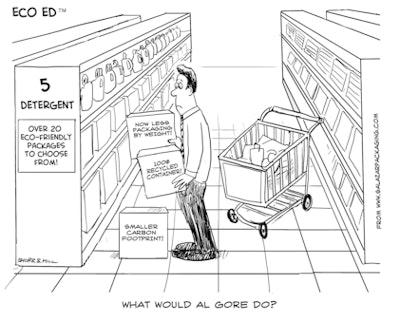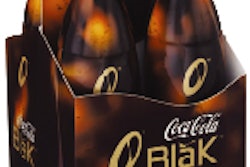
At the other end of the scale, the Nielsen survey found that consumers were least willing to give up packaging designed to keep products clean and untouched by others (27%); packaging designed to keep products in good condition (30%); packaging information in the form of food labeling, cooking and usage instructions (33%); and packaging that preserves products to make them last longer/stay fresher (34%).
One in 10 global consumers was not prepared to give up any aspect of packaging for the benefit of the environment.
"Our survey found consumers’ responses toward packaging reflected regional and lifestyle factors, which are all important considerations for Consumer Packaged Goods [CPG] companies," says Patrick Dodd, president, The Nielsen Company, (www.nielsen.com) Europe.
Generally, Europeans and North Americans were in agreement on the kinds of packaging they would forego to help the environment. Nearly 60% of Europeans and North Americans would give up packaging designed for stacking and storing at home, and 55% also said they were willing to give up packs that can be cooked in or kept at home as a resealable container.
Among Asians, however, 42% said they would be prepared to give up stack-and-store packaging, and only 39% would be prepared to forego "easily transportable" packaging. "Asian homes tend to be smaller and have limited storage space, so stack-and-store options are more practical and preferable," observes Dodd. "Asian lifestyles also determine that Asians are least likely to give up convenience packaging that can be cooked in or kept at home as a resealable container, and easy-to-transport packaging."
Over 70% of Finish, Irish, Norwegian, and New Zealand consumers said they would be prepared to give up stack-and-store packaging, and over 65% of Irish, Czech, and New Zealand consumers said they would be prepared to give up convenience packaging for the benefit of the environment.
Interestingly, environmentally aware New Zealanders topped global rankings as the nation most prepared to give up all these packaging aspects for the sake of the environment. This may in large part be due to high levels of "eco-consciousness," including in-store reminders and recyclable bag merchandising by supermarkets, and weekly recyclable rubbish collection instituted by local authorities in most cities.
"Asian consumers place a high priority on fresh food. Ninety percent of urban Asian shoppers go to Wet Markets to buy their main fresh food and shop as often as 10 times a month at traditional grocery stores. In Europe, Finnish shoppers visit the supermarket/hypermarket/discounters on average only six times a month, while French, Portuguese, Belgian, and Swedish consumers make eight shopping trips per month," according to Nielsen ShopperTrends. "In contrast, Asians’ frequent shopping trips for fresh food mean they don’t tend to buy food with packaging designed to prolong shelf life or preserve food," notes Dodd.
In Latin America—the world’s most concerned region about climate change, according to Nielsen’s Global Environmental Concern barometer—consumers were most willing to give up all other types of packaging if it would benefit the environment. These included packaging that preserves products for a longer shelf life, and packaging that includes labeling and cooking information, as well as packaging that keeps products in good condition and packaging for hygiene, which keeps products clean and untouched.
Overall, the two aspects of packaging that consumers would be reluctant to give up are "protective" packaging that keeps products in good condition and hygienic aspects of packaging that keep products clean and untouched by others.
Globally, Europeans (23%) and North Americans were least prepared to give up packaging for hygiene and protective purposes.
Thai consumers (27%) topped global rankings as the nation least likely to give up any aspect of packaging for the sake of the environment, followed by 16% of Japanese. According to findings from Nielsen’s packs@work™ studies in Asia, Japanese consumers claim aesthetics to be a strong driver of pack preference.
For retailers and the CPG sector industry, the results of Nielsen’s global packaging survey revealed vast differences between regions when it comes to attitudes towards packaging.
"The factors influencing packaging preferences across cultures include whether consumers drive themselves to the shops or if they rely on public transport, the size of their homes, and the storage space available in their kitchen. Cultural food and shopping habits are also main influencers in packaging choice," says Dodd.
"As global concern and awareness for the environment continues to grow, consumers around the world are demanding more action from retailers and packaged goods manufacturers to protect the environment. And while eco-friendly packaging might not be the top priority for shoppers today, it’s certainly a growing priority the food industry cannot ignore," says Dodd. In fact, according to Nielsen’s twice-yearly Global Environmental Concerns survey, consumers who said they were "very" concerned about packaging waste increased from 31% to 40% between May and November 2007. In the latest round of the survey, concern for packaging waste increased more than any other environmental concern, outpacing concern for climate change, water shortage, water and air pollution, and the use of pesticides.
According to Nielsen’s 360° proprietary pack research system, packs@work, food retailers and manufacturers are continuously striving to meet consumer demand for more eco-friendly packaging solutions that minimize impact on the environment. "In more eco-aware markets, there is an increasing expectation of packaging with minimal environmental impact, although for most consumers, this doesn’t necessarily translate into a willingness to pay more. What most consumers expect is packaging that provides an added ‘feel eco-good factor’ by minimizing environmental impacts," says Dodd.
In more eco-conscious countries, Nielsen packs@work studies reveal a consumer preference for packaging that is recyclable, biodegradable, and safe from a disposal perspective—using materials such as paper, cardboard, and/or glass rather than plastic or polystyrene. Glass packaging, for example, is considered to be hygienic, inert, recyclable, and tamper-proof, and has the potential to extend product life. And its aesthetic appeal provides positive cues about product authenticity, quality, and efficacy. "We are starting to see some backlash against plastics that are not recyclable, or whose chemical composition may lead to tainting or degradation of product quality," says Dodd.


























